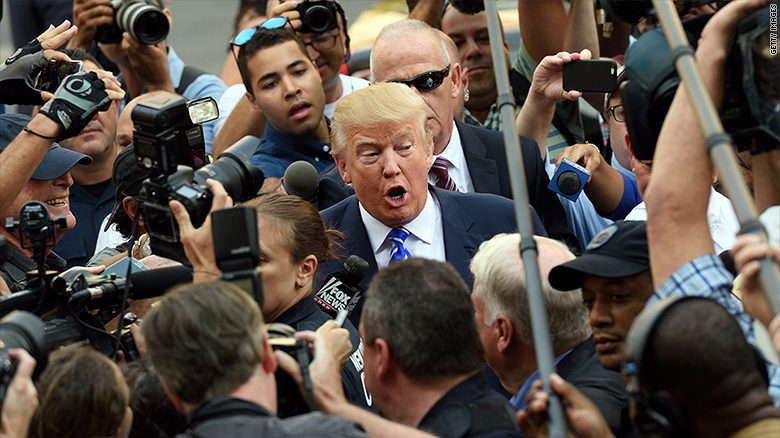
[dropcap]Digital[/dropcap] technologies and the pervasiveness and wide accessibility of the internet have fundamentally transformed the way journalists and advocates function. Because of the speed at which technology is advancing – and therefore the nature of the media is changing – we are still in the process of adjusting to the concept of networked advocacy and journalism.
Traditionally, broadcast and print journalism have been authoritative, and our relationship to them has been relatively passive. Now however, with comment sections on online articles, and the ease of contact with journalists via Twitter, our relationship with journalism has shifted.
In 2016 alone, we bore witness to the extent of the digital transformation and its effects on journalism as a profession. As digital technologies change, the traditional theories of communications research are no longer as relevant as they were prior to Web 2.0. In Benedict Anderson’s seminal work, Imagined Communities, he details the effects of the printing press on the idea of nationhood.
He writes that printing novels and newspapers in the languages of each country diminished the power of Christendom in Europe and ‘laid the bases for national consciousness’. In a similar way, the advent of the internet, and particularly social media, has enabled individuals from across the world to communicate and contribute to discussions with ease.
This effortless accessibility has allowed for new imagined communities to develop online. It has also allowed for advocates and activists to raise issues on a far wider platform than would have been possible prior to Web 2.0.
The invention of social media has made it possible for people from different communities to unite in favour of something they believe in, or in the face of something they oppose. The difference it has made to political conversations is difficult to overstate.
Where once groups or individuals would use flyers, posters and newsletters to advertise their meetings or public demonstrations, they now advertise and promote their causes via Facebook, Twitter and various other social media networks.
Social media communication has become a powerfully effective tool in the organisation of events and protests. Some notable examples of occurrences in which it has been used as a way of organising, mobilising and sharing information are the ‘Indignados’ protests in Spain in 2011 and 2012, the Arab Spring uprising of Egyptian, Tunisian and other Middle Eastern citizens, and the ‘Occupy Wall Street’ demonstrations in 2011.
Slacktivism
While social media undoubtedly makes it easier to get a message across to a large and diverse group of people, certain commentators have accused those who ‘like’ and share articles, instead of engaging with an issue offline, of ineffectual and perfunctory engagement with a political issue.
The argument – put forward by journalists such as Malcolm Gladwell in his 2010 article for The New Yorker – seems to be that the relative lack of energy that goes into ‘liking’ an article, typing your name into an online petition, or posting a tweet using a hashtag, is unlikely to achieve as much as physically making the effort to protest or demonstrate.
However, a study led by Professor Sandra González-Bailón of the University of Pennsylvania, published in November 2015, shows that ‘peripheral users in online protest networks may be as important in expanding the reach of messages as the highly committed minority at the core’.
In recent weeks, we have seen networked advocacy success stories in both large scale and small. The Dakota Access Pipeline protesters at Standing Rock achieved their aim of stopping the pipeline from being constructed across sacred Native American territory.
These activists used hashtags like #NoDAPL and #StandWithStandingRock to draw attention to their cause. On a smaller scale, on Twitter in late November, the retweeting of a man’s request for a specific type of Tommee Tippee cup for his autistic son, as he refused to drink from anything else, became such a viral sensation that the company sourced the mould of the cup and agreed to create a lifetime supply for the boy.
These examples demonstrate that, while online activism should not be used as a sole method of protest, neither should its importance in uniting people for a specific cause be underestimated.
Crowdsourcing and Citizen Journalism
Since the birth of Web 2.0, hundreds of millions of blogs have been created, abandoned and re-created, covering every topic imaginable. It is unsurprising that in this blog deluge, there is a large number relating to current affairs. Citizen journalism and crowdsourcing differ from regular blogging in that they are seen to be less opinions-based and more concerned with getting real stories from people ‘on-the-ground’, where the news story is occurring.
These stories, however, are not produced by professional journalists and, therefore, may not be up to the standard of mainstream journalism. In Andrew Keen’s book, The Cult of the Amateur, he raises this valid issue, ‘without editors, fact-checkers, administrators, or regulators to monitor what is being posted, we have no one to vouch for the reliability or credibility of the content we read and see’.
This point is furthered in Preditors: Making Citizen Journalism Work. However, while Keen disapproves entirely of the idea of citizen journalism, Wilson, Saunders and Bruns, the writers of Preditors, are more positive in their view of this emerging form of journalism, as they note its positive aspects, while emphasising that mainstream journalistic editorial standards must be maintained.
An example of citizen journalism that appears to work can be found in the Eliot Higgins created website, Bellingcat.com. Higgins started the website using funds raised from an online campaign and his mission is to bring to light news that happens ‘on the ground’ from information found online.
Similarly, the successful news media website Storyful.com combines videos and information submitted by citizens and amassed and edited by journalists who work for the company. According to their mission statement, ‘Storyful combines proprietary technology and expert journalism into a human algorithm. This game-changing combination gives us the ability to discover, verify, acquire and deliver the most valuable real-time content the social web has to offer.’
The factor that unites Bellingcat and Storyful is their appreciation of, and collaboration with, professional journalists. In the Siliconrepublic.com interview with Eliot Higgins states, ‘I’m always happy to work with the media and see how that develops’. This cohesion of professional journalism with citizen contributions appears to be a model that works. The emphasis of verification in the Storyful statement is important as in 2016, there has been a proliferation of fake news due, in part, to social media algorithms.
Journalism, Politics and Post-Truth Society
2016 was the year the Oxford English Dictionary made ‘post-truth’ its word of the year. The definition it supplies for this much-used term is ‘relating to or denoting circumstances in which objective facts are less influential in shaping public opinion than appeals to emotion and personal belief’. The rise of fake news being reported as real news brings with it potentially frightening consequences for the undiscerning reader. In 2016, we witnessed the rise of right-wing politics and a proliferation of fake news stories and conspiracy theories. During the 2016 presidential election, one particular conspiracy theory, which came to be known as ‘Pizzagate’, came to the fore.
Members of the website 4chan invented a paedophile sex ring based in a Washington pizzeria, and involving important members of the Democratic party and its donors. The story, though entirely unfounded, became a viral story on Twitter and was the reason a twenty-eight-year-old man entered the pizzeria on the fourth of December and threatened the staff with a firearm. Divisive politicians – such as Nigel Farage and, most notably, Donald Trump have also made numerous false claims in the past number of months.
Farage and the Brexit Leave campaign held as one of their core promises that £350 million would go towards the National Health Service in the event of a Brexit. He then backtracked on this claim mere hours after the Brexit votes had been counted. Trump has, among many other falsehoods, claimed that climate change is a hoax invented by the Chinese ‘in order to make U.S. manufacturing non-competitive’.
These politicians have shown through their incendiary and false statements, that people seem less interested in objective truth than ever before. This poses a crisis for traditional journalism.
Historically, the role of journalists has been authoritative. In William Merrin’s paper, Media Studies 2.0: upgrading and open-sourcing the system, he points out that the theories surrounding journalism and communication studies are outdated because of the digital revolution.
During the era of what he calls Media 1.0, broadcast media was king. It was, he says, ‘dominated by large organisations mass-producing information and products for mass-distribution and mass consumption.’ In contrast, in today’s digital world ‘open-access amateur production challenges closed-access, elitist, hierarchical professional structures.’. Both print and broadcast journalism have traditionally been considered somewhat elitist.
There has always existed a form of media bias that deemed certain news stories of interest and others, in less newsworthy locations, to be unworthy of publication. Media bias can also occur when a wealthy business person owns newspapers. There have been questions into whether certain newspapers can truly be independent when they are owned by businessmen who are quick to use libel laws to protect their name.
In a way, citizen journalism has democratised the sharing of news. However, although the work of journalists has occasionally been inaccurate, misleading or biased in some way, there is a framework in place to make sure that articles are fact-checked prior to publication. This limits the number of mistakes that are made and prevents misleading information being spread. If the information is proven to be wrong after publication, a correction is issued when the error is discovered. Despite this, levels of trust in journalism appear to have plummeted.
Accusations of ‘media bias’ have been levelled at print and broadcast journalists for years, however it is only since the digital revolution that we have seen the effects of the diminishing levels of trust in mainstream journalism. Recent statistics have shown that the number of people buying newspapers has been dropping significantly for the past number of years. Because of the diminishing sales in print newspapers, there have been numerous job losses.
We have come to expect our news to be free. In 2015, Independent News and Media let thirty of its editorial staff members go. In the UK, the print edition of InStyle magazine was discontinued as the company became digital only. While many of us read the news online from the newspaper’s equivalent website, we are increasingly looking to social media to provide our news. The danger of this lies in the power of the algorithm.
Social media sites, such as Facebook, use an algorithm to determine what articles show up on our news feeds. It will only show us the information that it deems relevant to us, based on what we have previously clicked on or ‘liked’. The algorithm not only applies to news articles, but also to our friends or followers on the social media platform.
It streamlines what appears on our newsfeeds, so that eventually only the opinions that seem similar to ours are visible. This is the echo-chamber effect, also known as the ‘filter-bubble’, and it is believed by many to be partially responsible for the rise of right-wing politics across the globe.
Digital technologies have transformed how the work of journalism is perceived by the reader. With the sheer volume of information constantly emerging from innumerable sources, people are able to pick and choose what they want to read and believe. We are also able to make false stories spread at a rate unprecedented prior to Web 2.0. In an article written by the Guardian editor Katharine Viner in July 2016, she highlights the diminishing importance of truth in what is considered journalism.
Viner also highlights the fact that news organisations such as the Guardian are being forced to publish trivial news stories to attract clicks and page views instead of prioritising good journalism. As she puts it ‘the new measure of value for too many news organisations is virality rather than truth or quality’.
This problem has become so prevalent that last August, the presenter of the US TV show Last Week Tonight, John Oliver, parodied the fact that frivolous news stories were being shown as having the same level of importance as crises occurring across the world, and warned that if we do not protect our news organisations by paying for our news, we risk losing access to valuable information provided by qualified professionals.
In order to maintain journalistic standards, it is necessary to pay for truthful, independent journalism and encourage the use of fact-checking websites. The advancements in digital technologies have altered journalism and advocacy to an extreme degree, and it is clear that we are still suffering the growing pains that come with such rapid changes.
Caitríona Phelan





Leave a Reply